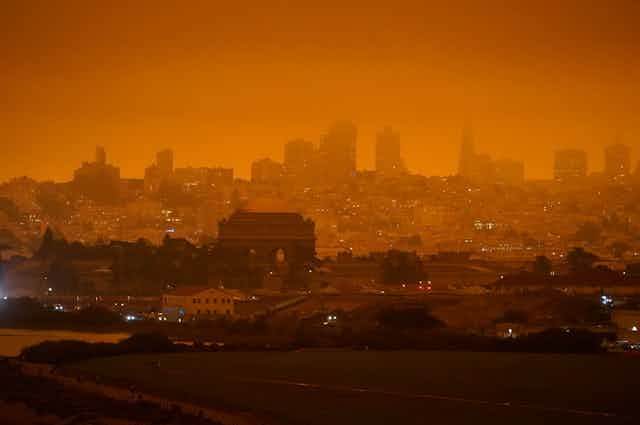Wildfires have burned millions of acres in the western United States this year. Tens of thousands have been evacuated and thousands of buildings and other structures destroyed. Thick smoke blankets much of the region — colouring the skies red and orange — and is flowing north into British Columbia and Alberta. Tens of millions of people have been exposed to these hazardous conditions.
Wildfire smoke is a complex mixture of fine particulate matter, called PM 2.5, and gases, such as volatile organic compounds, nitrogen oxides and carbon monoxide. The composition of the mixture depends on many variables, including the fuels that are burning, the temperature of combustion, the weather and the distance from the fire. Although wildfire smoke is different from the air pollution caused by traffic and industry, it is also harmful to human health.
Wildfires cause episodes of the worst air quality that many people will ever experience. Fine particulate matter can be inhaled deep into the lungs, where it may lead to systemic inflammation that affects other parts of the body.
On smoky days, more people visit emergency rooms, more people are admitted to hospital and some people will die because of the smoke exposure. We also know that PM 2.5 can affect the immune system, which may make some people more susceptible to acute respiratory infections such as influenza and COVID-19.
Coping with intense and prolonged wildfire smoke is difficult, both physically and mentally. I have been studying how this unpredictable and extreme type of air pollution affects the respiratory and cardiovascular health of exposed populations for many years. Here are 10 tips to protect yourself and your family from the risks of wildfire smoke.
1. Understand your susceptibility
Some people are at higher risk of experiencing health effects from smoke, especially those who have asthma, COPD, heart disease, diabetes, other chronic conditions or acute infections such as COVID-19.
Pregnant women, infants, young children, older adults and people who work or live outdoors are also more susceptible. Anyone who uses rescue medications should carry them at all times.

2. Listen to your body
Different people can have very different reactions to the same amount of smoke. If you feel unwell, listen to your body and take actions to reduce your exposure.
The most common symptoms include eye irritation, sore throat, cough and headache, which usually disappear when the smoke disperses. Anyone who has more severe symptoms such as difficulty breathing or heart palpitations should seek medical attention.
Smoke is an environment hazard to be respected, not a personal challenge to be overcome.
3. Take it easy
The harder you breathe, the more smoke you inhale. The average resting adult breathes about six litres of air per minute, but this can easily increase to 60 litres during intense exercise.
Taking it easy is one of the simplest ways you can limit your exposure.
4. Use a portable air cleaner
Portable air cleaners with HEPA filters can significantly reduce indoor PM 2.5 concentrations when used properly. Smaller units can be used to keep one room relatively clean as a place to seek relief when needed.
A high quality furnace filter taped to a box fan can also do a pretty good job in a small room, although do-it-yourself devices should never be left running unattended.
Read more: How will Canada manage its wildfires in the future?
5. Seek comfortable spaces in the community
Public places such as libraries, community centres and shopping malls often have large air filtration systems and relatively good indoor air quality. Unfortunately, access to some of these spaces may be restricted during the COVID-19 pandemic, so making a comfortable space at home is more important than ever.

6. Consider wearing a protective mask
One silver lining of the COVID-19 pandemic is that we have learned new things about face masks. Although a well-fitted N95 respirator will always be the best option for wildfire smoke, recent research shows that other masks can provide reasonable protection from PM 2.5 if they are closely fitted around the face. Masks with multiple layers of different materials were the best for filtering fine particles.
7. Drink plenty of water
I know, I know … everyone is always telling you to drink more water. Staying well-hydrated helps the kidneys and liver to remove toxins, which can reduce any systemic inflammation caused by wildfire smoke exposure.
8. Know where to find information
The air quality impacts of wildfire smoke can change fast. Know how to stay updated on conditions in your area. Smartphone apps such as the Air Quality Health Index (AQHI) in Canada and SmokeSense in the United States can send alerts when air quality starts to deteriorate.
9. Pay attention to wildfire smoke forecasts
Forecasting wildfire smoke is even more difficult than forecasting the weather, but the models are improving every year. Tools such as FireWork in Canada and BlueSky in the U.S. show smoke predictions for the next 48 hours.
Read more: Climate change and wildfires – how do we know if there is a link?
10. Start preparing for next season now
Wildfire seasons are getting longer and more extreme as the climate changes. The best way to protect yourself from smoke is to plan and prepare well before the smoke arrives. There is increasing recognition that we must learn to live with wildfire and smoke in western North America.
On that note, I often get asked about the long-term health effects of extreme and repeated wildfire smoke exposures. Not much is known at this time, but it is an area of active research and I think we will learn a lot in the next five years. Even so, please remember that taking action to reduce exposure in the short-term will also help to protect you and your family in the long-term.


